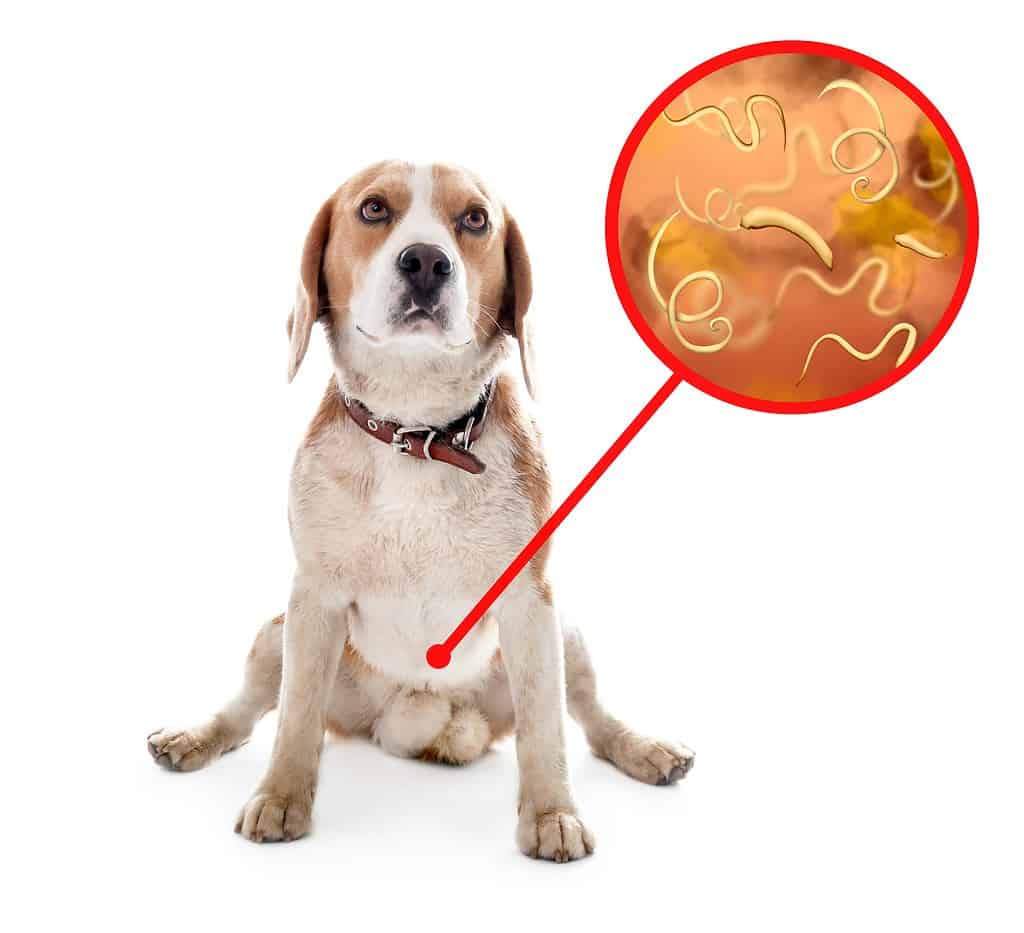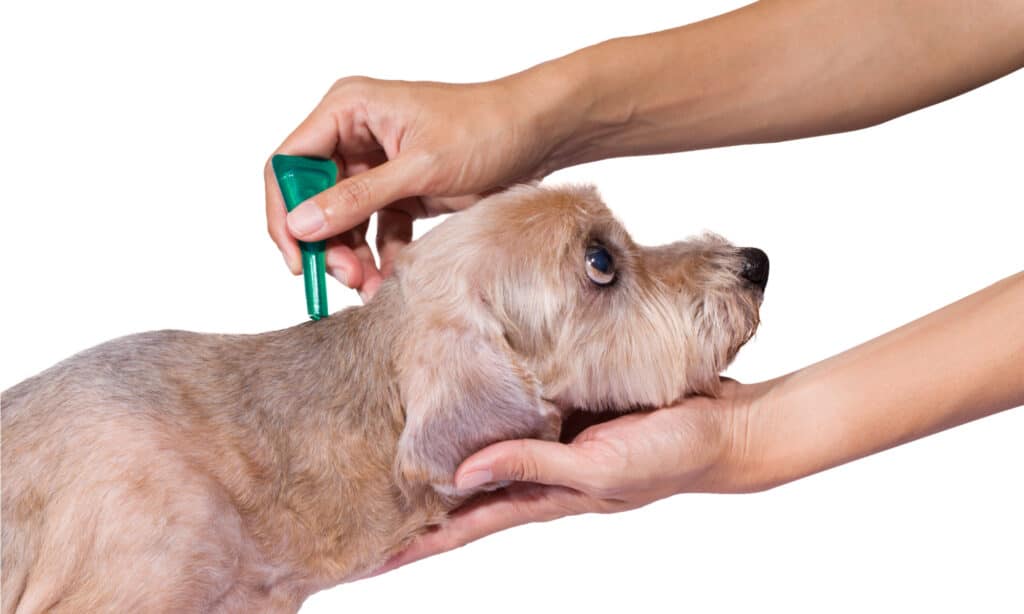Maybe you’ve noticed your dog scoots their bottom across the floor. Or they’re acting like their bottom itchs and irritates them. Though these symptoms could be from anything, you see white rice grains in their bowel movements. What’s going on? Unfortunately, your dog likely has worms. The worms in dogs that look like rice are known as tapeworms. Here’s what you need to know about these parasites.
What Is a Tapeworm?

Tapeworms attach to a dog’s intestinal walls.
©New Africa/Shutterstock.com
This parasite is a flatworm that makes its home in human or animal intestines. A tapeworm attaches to the inside of the intestines and feeds off the food digesting there. As the tapeworm’s body grows, it lays eggs that pass through the intestines and come out in its host animal’s poop. Other creatures who ingest the eggs become infected.
How Do Dogs Get Tapeworms?
A dog may get a case of tapeworms by ingesting an infected flea. The flea doesn’t have to be on your dog. Other animals, such as cats, birds, rabbits, or rodents, can transmit tapeworms to your dog. The tapeworms don’t even have to be on a living host. Though the eggs mainly come out in poop, they can hypothetically spread anywhere the infected animal goes, such as carpets, dog beds, and furniture.
Once your dog ingests the infected flea, the tapeworm eggs invade the small intestine and develop into adult worms. Since the worms are in the dog’s intestines, they are present in the dog’s bowel movements, where you can see signs of infection. The worms break up into rice-size segments when they come out of your dog’s body. However, a fully-grown, unbroken worm can measure as long as 28 inches!
Types of Tapeworms
There are several types of these not-very-pleasant parasites.
Dipylidium caninum is the most common tapeworm to affect dogs. It’s the type that transmits by ingesting an infected flea. Animals may also pick up the parasite if they scavenge on rodents that carry it. Additionally, humans and animals can pick up other types of tapeworms from sources such as contaminated water and undercooked, infected beef.
Tapeworms: Dangers

A close-up of the worm in dogs that looks like rice.
©Vinicius R. Souza/Shutterstock.com
Other animals can pick up tapeworms from an infected animal’s droppings. You must clean up an infected dog’s poop from outside to avoid spreading worms to others.
It’s also possible for pets to infect their humans. The worms themselves are not directly contagious, but the risk is if you accidentally ingest a worm or an infected flea. For example, this could happen if your pet licks your face or your dog sleeps with you and infects your bedding. The most important thing to do to prevent the spread of tapeworms is to treat the infected animal.
An infection of these intestinal parasites can make your dog’s bottom extremely uncomfortable and itchy. They may also cause gastrointestinal issues. But in puppies or older dogs, the worms can do more damage. They may stunt growth, cause blockages, or even lead to anemia. It’s important to treat a case promptly so that the animal doesn’t continue to leave rice-like droppings, which, let’s face it, is something you don’t want in your home.
Treating Tapeworms

After you deworm your dog, treat them with a flea preventative.
©Chutima Chaochaiya/Shutterstock.com
The best line of action is to head to your veterinarian when you discover the infection. A drug called praziquantel is an often-used parasiticide that veterinarians give via mouth or by injection. There are also dewormers available over the counter. The treatment works by making adult tapeworms detach from the dog’s intestine. The tapeworms can then pass through the body.
Side Effects and Dosage
The medication dose goes by weight, so you need to give the right amount for it to work correctly. Also, know that the drug may show some side effects in your dog, including vomiting, diarrhea, lethargy, and loss of appetite. This doesn’t mean the medicine isn’t working, but it’s a good idea to check in with your veterinarian if this happens.
Home Remedies
After you treat the dog’s infection, give a monthly dewormer to stop recurrent worms. You may wonder if you can make anything to treat your pet at home. There aren’t other proven remedies for deworming. Apple cider vinegar, pumpkin, and garlic are commonly suggested natural treatments, but they cannot cure the condition. A parasiticide treatment is the first and best line of defense.
How to Avoid Tapeworms
Since dogs most easily get tapeworms from infected fleas, the most important thing you can do is ensure your dog is on a flea and tick prevention treatment. Whether topical or oral, a flea and tick preventative works by releasing a pesticide on your pet’s skin. The flea dies when they come in contact with it.
This is especially important to use if your dog goes to many public spaces, including dog parks, which raises the risk of coming in contact with tapeworms. Tapeworm eggs and larvae are known to survive for weeks and even years in busy outdoor spaces like dog parks.
Additionally, be sure to clean up your dog’s poop and keep your dog away from other animals’ poop since it’s a known source of transmission.
How Long Until My Dog’s Tapeworm Infection Clears Up?
With proper dosing, a deworming treatment starts to go into effect within a few hours. However, it could take a couple of weeks for the worms to stop appearing in your dog’s poop. But you’ll know if the treatment works because the worms will die.
As disgusting as tapeworms are, the condition is luckily very treatable. Don’t be alarmed if you see this happen to your dog; there are easy resolutions!
Ready to discover the top 10 cutest dog breeds in the entire world?
How about the fastest dogs, the largest dogs and those that are -- quite frankly -- just the kindest dogs on the planet? Each day, AZ Animals sends out lists just like this to our thousands of email subscribers. And the best part? It's FREE. Join today by entering your email below.
Thank you for reading! Have some feedback for us? Contact the AZ Animals editorial team.








